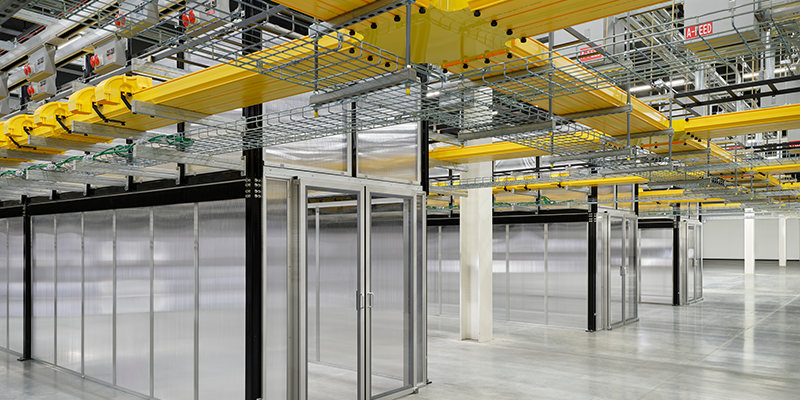By Marie Ruff
With the demand for data centers skyrocketing, mastering the intricacies of developing this high-demand asset can provide a valuable competitive edge. A panel of experts at NAIOP’s I.CON East this week in Jersey City, New Jersey, delved into the strategic nuances of data center development, addressing critical factors such as site selection, land evaluation and the optimization of infrastructure to meet both current and future needs.
After polling the audience, session moderator Marie Purkert, on the national client leadership team at Kimley-Horn, noted that while half of the attendees in the room said they have worked on a data center this year, that number was closer to a quarter of the attendees at the I.CON East conference last year – a sure sign of this specialized sector’s immense growth.
Purkert shared some eye-opening stats:
- The global data center market is expected to grow 8 to 10% annually, while the U.S. market is expected to grow 10% to 11% through 2030.
- Investment in network infrastructure is expected to dominate the market, with over $2.5 billion in 2025. “This is especially important because the federal government has now classified this as a premium asset in the economy,” Purkert said.
- U.S. power consumption will double from 17GW to 35GW, with data centers consuming up to 12% of total U.S. electricity by 2028.
- Global power demand is expected to grow to 130GW by 2028, and an estimated $720 billion in spending on the grid may be needed by 2030 to improve bottlenecks.
“We’re leasing it before it ever comes out of the ground,” said Jeff Green, economic development program manager, QTS Data Centers, about the company’s data center inventory. “Demand is outstripping the supply immediately.”
In terms of site selection, it’s not necessarily the location that matters, but access to power.
“Power has always been king,” Green said. “Two to three years ago, we could identify a site and figure out how to get power to the site. Now we’re trying to find sites that are located at the power, and more broadly than that, we’re thinking about how we can generate power on our own.”
“Site selection is power first, everything else second, at the moment,” said Denver Parys, director of portfolio planning, Edged Energy. “Really, the building and the box are the easy parts. Bringing power is what everybody’s trying to solve for.” Secondary concerns include zoning and entitlements, he noted.
Purkert asked if the panelists are looking at innovative solutions and considering any behind-the-meter solutions – maybe not deploying them now, but in the next 3-5 years.
“We’re looking at a variety of energy solutions,” Green confirmed.“At the end of the day, we build and operate the data centers,” Green said. “It’s our customers who are going to put the servers in the building, and so they’re going to be the ones who help us understand what their demand is for behind-the-meter solutions, or whether they’re more interested in just bridging over to grid power, when that power can catch up.”
“It’s really finding a solution that the hyperscalers are willing to accept from a co-lo provider,” Parys said, referencing colocation – the practice of renting space for servers and other computing hardware in a third-party data center. Hyperscalers are massive, specialized facilities built to handle enormous data volumes and workloads; they often serve tech behemoths like Amazon, Google and Microsoft.
“There are obviously sites where the hyperscalers are doing it on their own,” Parys added. “There’s a lot in play.”
“Siting data centers is getting harder. When you throw in self-generation or behind-the-meter solutions, it makes that challenge of assigning a data center [determining the location, space, and design layout for hosting servers and other IT infrastructure] and getting local approvals that much harder,” Green said. “It’s a part of the conversation that I expect we will continue to have.”
Next, Purkert asked how the speakers were managing the community engagement piece, and whether this impacted their speed to market.
“So much of what we’re doing to address community inquiries and NIMBYism is around education about what it is we do and what it is we don’t do. There’s a lot of misinformation about what data centers do,” Green said.
“Every single person is voting with their pocketbook, and they want data centers, but they’re not necessarily as thrilled about the idea of it coming to their community,” Green said. “We need to educate them as to why it’s important for the broader economy, for their community, and let them understand what it is in it for them.”
Green noted that in Loudoun County, Virginia, for every $1 in services that the county provides to data centers, it receives $26 in tax revenue.
Green said his company was an early adopter of adding their logo to their data centers as a sign that they were present and part of the community, and not just a nameless box. “That public engagement piece and getting ahead of that is incredibly important,” Green said
“It’s also about how the cities are planning for these investments to come into their area,” Parys said. “We’re working in Iowa, and they created almost a data center hub. They aren’t sprinkling these mega buildings throughout the community; they zoned that area and it’s very much concentrated.”
“They’re not necessarily warehouse-looking metal buildings,” he added. “We spend the CapEx on the infrastructure itself, which makes it very attractive to those cities.”
Purkert asked the speakers how companies that want to get involved in the data center market could get started, and where they could find opportunities. Since these are fast-paced, multi-billion-dollar investments, it pays to have experience in the data center space so companies feel comfortable relying on firms that have been there and done that, but how do you break in initially?
“If you can find a partnership or a joint venture with someone who’s already in data centers, that is a prime way to get into the market,” Green said. “But there’s so much work out there,” Green said. “There are probably opportunities where you can subcontract and partner with a company that’s doing data center work to build your resume [in the space].”
“If you’re on the broker side, be an expert – particularly on power for your sites,” Green said. “I need to know how much power is available, when it can be delivered, what’s the ramp-up schedule, is there infrastructure, does the utility even have the equipment?”
“I get emails from different folks who have land, who say there’s a power line that goes there, but that doesn’t really give us any information,” Parys added. Specifics are key, especially when power is king.

This post is brought to you by JLL, the social media and conference blog sponsor of NAIOP’s I.CON East 2025. Learn more about JLL at www.us.jll.com or www.jll.ca.








